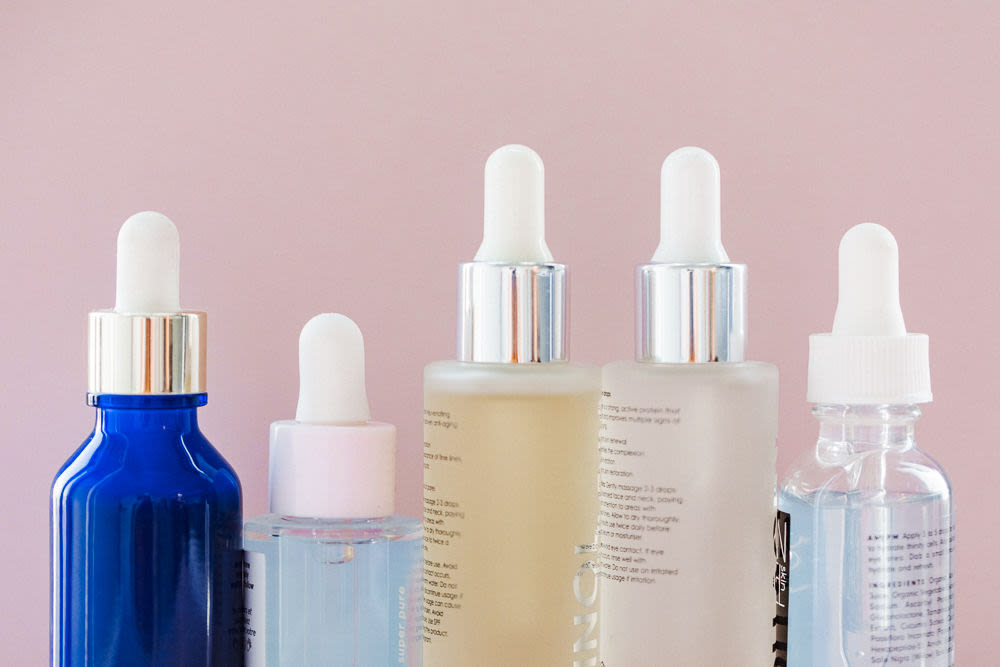Was it….us? These days, more and more people are “into” skincare—market reports show that shoppers are trying and buying lotions, serums, and masks in record numbers. As a blog that devotes a decent amount of time to the subject, we couldn’t be more excited. Truly! But, as you start this journey, ITG wants to add a little assist. Namely, we’ve put together an essential ingredients guide for yours truly—it’s your map to sussing out the key skincare ingredients that matter most. It is not a trendy ingredients guide—no rare tropical fruits and plants to been seen here. Instead, we’ve assembled a concise collection of ingredients that you should look out for in your skincare wardrobe. Scientific studies-backed and the tried-and-true. Whether they land in your weekly mask or daily serum, these are the ingredients that you should always have in your bathroom cabinet.

Vitamin C
Category: Antioxidant
You ought to know: That vitamin C it’s a notoriously unstable ingredient, meaning that it’s quick to lose potency and efficacy when exposed to light and air. However, fear not. Newer derivatives of the vitamin, like magnesium ascorbyl phosphate, sodium ascorbyl phosphate, and ascorbyl glucoside are significantly more stable.
Best time to use: In the morning, once a day
What it does: It’s your average dullness-eliminating, wrinkle-preventing, collagen-boosting ingredient. It does a lot! Which makes it arguably more valuable than any other ingredient on this list. Say you’re prone to hyperpigmentation, i.e. dark spots. Because vitamin C works to help skin repair itself, consistent use “protects the skin daily from free radicals and reduces hyperpigmentation,” says board-certified dermatologist Dr. Lian Mack. And at the very least, it lessens the intensity of dark marks that have powered through. Even if hyperpigmentation isn’t a concern, vitamin C brightens skin ever-so-slightly, so you’re complexion doesn’t come off as dull.
As Dr. Mack mentioned, vitamin C also fights free radicals. What are free radicals, you ask? More on that, here, but for the purposes of this post, just think of them as airborne stressors that add wear and tear to your skin. This wear and tear over time can lead to skin that’s not as firm and resilient. Additionally, vitamin C “boosts” collagen production. So your skin can consistently manufacture more collagen, which in turn acts as a first defense against fine lines.
Try: Mad Hippie Vitamin C Seurm, Glossier Super Glow, or Beauty Rx Triple Vitamin C Serum.

Zinc
Category: Antioxidant
Best time to use: Every day—morning, night, or both
What it does: This quiet hero has been around for a while, but we’re only beginning to really appreciate the scope of its work. Above all else, zinc behaves as an anti-inflammatory agent and calms irritated skin. “Zinc is not traditionally thought of as an antioxidant,” says Dr. Mack, “but it does help to protect the skin from pollutants and free radicals." It's primed to treat pimples (by attacking inflammation and redness), skin-sensitivity, and beyond. Dr. Mack also adds that “it can prevent acne flares because of the role it plays in cellular turnover and decreasing natural oil production.” Studies show that it lessens the severity of warts, rosacea, psoriasis, eczema, and keloids. Not because it treats the root cause of those conditions—which are varied and generally all over the place—but because it calms the physical manifestation of those conditions, like raised skin and redness. So, the big takeaway? Zinc gets skin to relax.
Try: Aesop Sage & Zinc Hydrating Cream, Pai Perfect Balance Blemish Serum, or La Roche-Posay's Serozinc Face Mist.

Hyaluronic acid
Category: Humectant
You ought to know: Not all hyaluronic acid products are built the same. The best ones contain not one, but multiple forms of the ingredient at different molecular weights. Why? The smaller weight works to deliver instant results—hydrated, comfortably cushy skin. While the larger weight takes a bit longer to work its way into your skin. The slow and steady maneuver comes with a lasting benefit—hydration that's released continuously throughout the day.
Best time to use: Literally whenever you want
What it does: Hyaluronic acid is a different kind of acid. It doesn’t buff away dead skin cells or dive deep into your pores to push out dirt and grime (our friends alpha hydroxy acid and salicylic acid do that). Instead, it is a water-attracting molecule, making way for soft, hydrated skin. As Dr. Mack puts it, “when cells are full of water the skin appears more supple, and there are less fine lines and wrinkles.” The kicker is that unlike most other moisturizing ingredients, hyaluronic acid is incredibly lightweight. If you have oily skin, you’ll love it. If you have dry skin, you’ll really love it.
Try: SkinCeuticals' Hyaluronic Acid Intensifier, Vichy Mineral 89 Daily Skin Booster Serum, or Glossier Super Bounce.

Niacinamide
Category: Antioxidant
Best time to use: As needed to address pore size, or once daily to balance oily skin
What it does: Niacinamide is a relatively new guy on the scene. It’s a form of vitamin B—B3, to be specific. In the same vein as vitamin C, niacinamide is a bit of a powerhouse ingredient. “I use niacinamide routinely in my office for patients with inflammatory skin conditions like rosacea and acne,” explains Dr. Mack. And studies support that it addresses signs of aging (it is an antioxidant, after all), by softening fine lines, and reducing instances of hyperpigmentation and sallowness. Like zinc, it reduces inflammation—particularly acne and rosacea-induced irritation, and it also balances the amount of oil your skin will produce. If you’ve got oily skin in particular, niacinamide is equipped to regulate (and slow down) how much oil your skin generates. And with skin that’s less oily, pores appear smaller. It’s a win-win all around.
Try: Marie Veronique Soothing B3 Serum, Glossier Super Pure, or SkinInc's Vitamin B3 Serum to Rescue Troubled Skin.
Photo via ITG

